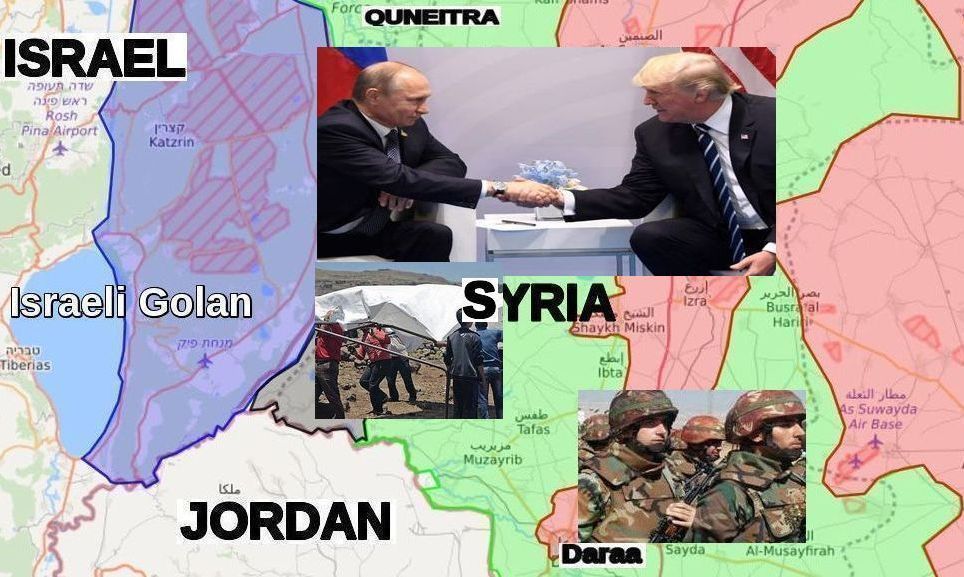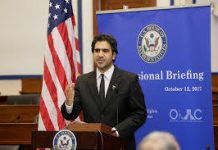Trump lets Putin have Syria for a summit, Iranian/Hizballah gain access to Israel’s border on refugee backs
ترامب يسلم سوريا لبوتين مقايل لقاء قمة معه، وإيران وحزب الله بحصلان على مدخل إلى حدود إسرائيل من خلال اللاجئين
DebkaFile/June 29/18
Israel’s armed forces are distributing tents, food, water and medicines to the tens of thousands of Syrian refugees reaching its Golan border in flight from the incredibly brutal Russian and Syrian air strikes on southern Syria. The figures are staggering – 342 air strikes on Thursday night, June 28, against rebel-held towns near the Israeli and Jordanian borders – of which 299 were conducted by the Russian air force and 43 by Syrian pilots. Nawa, a town opposite the Israeli Golan border took the heaviest bombardment.
Israel’s military correspondents, playing ball with the IDF, are withholding these horrific figures from the public, and so people don’t understand how 60,000 refugees fleeing from Nawa are suddenly fetching up on Israel’s northern border and joining the 20,000 already encamped there. While the IDF’s humanitarian conduct is laudable, the reason for the disaster is not. This new human catastrophe could have been prevented had the IDF acted in time to preempt the threat to Israel’s borders, and countered the onslaught on Daraa mounted by Assad’s army and allies with Russian air support 10 days ago.
However, Israeli inaction was part of another development not shared with the Israeli public: President Donald Trump quietly decided to let Syria go to Russia in the interests of a successful summit with Vladimir Putin in Helsinki on July 16. Israel, Jordan, the Syrian rebel and Kurdish groups hitherto backed by the United States were left to fend for their own security as best they could. As a last concession, the US turned a blind eye to Putin’s pass for Iranian and Hizballah forces to move in along with the Syrian army.
The Russian president grabbed the opportunity By unleashing heavy air bombardments for clearing the rebels still holding out in southern Syria from the path of Assad’s army – he trampled the pledges he gave Israel and Jordan and triggered an exodus of Syrian refugees who, finding the Jordanian border shut against them, headed for Israel’s Golan border.
The tens of thousands settling on Israel’s doorstop could swell, according to some estimates, to 200,000 or 250,000. Israel finds itself saddled with a mounting new security and humanitarian burden in the north, on top of the Gaza Strip in the south. Middle East reality is such that the tent encampments the IDF is providing as makeshift havens for refugees will in no time accommodate infestations of dangerous Syrian, Iranian and Hizballah agents. Desperate refugees will accept a few dollars to support their families for donning bomb belts and blowing themselves up against Israeli positions on the border fence.
It is already happening on the Syrian-Jordanian border. Syrian military intelligence has seized control of the large Rubkan refugee camp in Daraa and Jordanian security services are helpless to keep Iranian and Hizballah agents out.
How is the IDF going to prevent this disastrous security calamity from developing on Israel’s northern border? As word spreads across Syria that food, shelter and medical treatment are available, the refugee population sitting on Israel’s border around Quneitra will swell to unmanageable proportions. For Iran and Hizballah, a large refugee camp is the perfect lair from which to reach and terrorize northern Israel.
Trump-Putin Understandings on Syria: Regime Returns to South in Return for Iran Exit
London – Ibrahim Hamidi/Asharq Al-Awsat/Friday, 29 June, 2018/The Syrian regime’s offensive, with Russian aerial cover, on the southern Daraa province is part of a series of understandings between Washington and Moscow over the war-torn country, revealed western diplomatic sources to Asharq Al-Awsat. The two sides agreed to return the regime forces to the South in return for the departure of opposition factions to Idlib and Iran’s complete exit from Syria. The understandings on southern Syria will be on the agenda of the upcoming summit between US President Donald Trump and Russian President Vladimir Putin in Helsinki on July 16. US National Security Adviser John Bolton was in Moscow on Wednesday where he met Putin and Foreign Minister Sergei Lavrov ahead of next month’s Trump summit, which will be held after a NATO meeting in Brussels scheduled for July 11 and 12. Trump and Putin are expected to give priority for the formation of a government, opposition and civil society committee and for carrying out constitutional reforms to pave the way for presidential and parliamentary elections in 2021. They will also voice support for the efforts of United Nations special envoy to Syrian Staffan de Mistura to form a constitutional committee that can tackle these reforms. The current American and Russian agreement implicitly means accepting the continuation of Bashar Assad at the head of the Syrian regime despite ongoing statements opposed to his rule. The latest of these remarks came on Wednesday from US Secretary of State Mike Pompeo, who said that there can be no peace with Assad and Iran in Syria, said the western sources. Moreover, they revealed that the European Union and majority of European countries were not at ease with the understandings reached between Washington and Moscow. They are likely to remain committed to their stance that rejects Assad’s presence and refuses to contribute to Syria’s reconstruction until a political transition is achieved there. Many countries have also expressed their doubt that Russia was willing or even capable of weakening Iran in Syria.
Trump was keen to dispatch Bolton to Europe to inform his allies of his administration’s upcoming approach on Syria. This new policy was a product of a series of internal consultations, as well as discussions with Israeli Prime Minister Benjamin Netanyahu. The Israeli official played a central role in convincing Putin to accept some factors of the understandings, the essence of which was the need for the Syrian regime to return to the South and weaken and later end Iran’s role in the country. Netanyahu had paid a visit to Moscow in early May. His trip was soon followed by a comprehensive Israeli strike against Iranian positions in Syria, meaning that this move was approved by the Kremlin and coordinated with the Russian Hmeimim air base in Syria. Israeli Defense Minister Avigdor Lieberman declared at the time that Assad must end Iran’s presence in Syria. Contacts between Washington and Tel Aviv soon followed. They agreed to launch the regime’s military offensive on Daraa, reaching all the way to the Nassib border crossing with Jordan. Attacks on Quneitra and the western part of the de-escalation ceasefire zone would be postponed. Washington also informed opposition factions in the South that it will not intervene militarily in Daraa and Jordan announced it will not receive any Syrians fleeing the southern offensive. This American message will pressure Moscow to commit to the de-escalation zone agreement that it signed with the US and Jordan in July 2017. The message also signifies the abandonment of the opposition and commitment to arrangements between Washington, Moscow and Amman, possibly even Tel Aviv, that call for returning the regime to the South and keeping both Iran and the opposition out of the area.
These American-Russian understandings are part of a wider US strategy on Syria. The western sources told Asharq Al-Awsat that Trump is still committed to withdrawing his country’s troops out of northeastern Syria as soon as the ISIS terrorist groups is defeated. The organization still controls 2 percent of Syrian territory. Northeastern Syria will also be tackled by Trump and Putin in Helsinki where they will address the non-engagement agreement between their troops. Ankara may likely enter the picture after it returned in Washington’s good favor as demonstrated in the recent deal on the northeastern Syrian city of Manbij. The sources stated, however, that question marks still remain over the opposition-held Idlib province and the fate of Turkish forces there. Ankara has stated that it wanted to keep its influence there and northern Syria for the long-term.
Putin and Trump Have Nothing to Talk About
Leonid Bershidsky/Asharq Al Awsat/June 29/18
BloombergThe meeting between U.S. President Donald Trump and Russian President Vladimir Putin, which was confirmed by Trump’s national security adviser, John Bolton, would serve two purposes: The U.S. president loves playing the international statesman and Putin likes to look reasonable and constructive. They will have an opportunity to inhabit those roles. But there is no agenda for them to discuss, much less a substantive goal for their talks. And even if they appear to agree on something, it will likely be dialed back by Trump’s advisers and Congress.
The two leaders could discuss Trump’s suggestion that Russia should rejoin the G-8.
The agenda could also cover the U.S. president’s reported stance on Crimea, which he said belonged to Russia because its residents speak that language (and not because Putin annexed the peninsula in 2014). But Trump doesn’t have the authority to extend invitations on behalf of the other members of the group of industrialized nations, which have been explicit about not wanting Putin in the club. In addition, Putin doesn’t seem eager to rejoin that group; he appears happy to be part of the G-20 format along with other non-Western leaders such as Xi Jinping of China, Narendra Modi of India and Recep Tayyip Erdogan of Turkey.
Nor is Trump authorized to recognize the Crimea annexation even if he wanted to. It’s up to Congress, which could also lift Crimea-related sanctions, and there’s no chance either will happen. At a news conference in Moscow after his meeting with Putin, Bolton said the U.S. didn’t regard Crimea as part of Russia. Nor did Bolton dangle the possibility of any sanctions being lifted before the Russian-Ukraine conflict is resolved.
Still, there are other things Putin might want from Trump, including a pullback of North Atlantic Treaty Organization forces from Russian borders, a U.S. recommitment to the 1972 Anti-Ballistic Missile Treaty, a withdrawal from Syria, a return to the Iran nuclear deal and the end of U.S. support for Ukraine. None of those concessions are on the table.
The reason the U.S. can’t concede anything to Putin has little to do with principles and values, or with Special Counsel Robert Mueller’s investigation into putative collusion between the Kremlin and the Trump campaign in 2016. Instead, no give and take is possible because Putin has nothing to offer the U.S. as there is no part of the Trump agenda that Russia could help advance.
That meeting wasn’t meant to produce a specific result, just to break the Cold War ice (though that didn’t prevent a multitude of severe clashes over the subsequent 30 years). Trump and Putin might be able to take some of the heat out of what the former U.S. ambassador to Russia Michael McFaul has termed a “hot peace.”





















